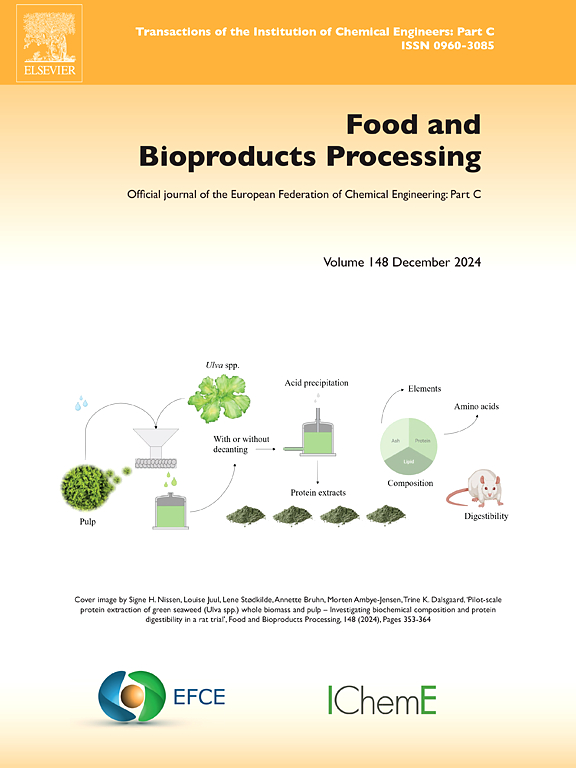Inulin and β-glucan fortified Alphonso mango juice serves as a sustainable and effective probiotic delivery vehicle for Pediococcus pentosaceus
IF 3.4
2区 农林科学
Q2 BIOTECHNOLOGY & APPLIED MICROBIOLOGY
引用次数: 0
Abstract
Fruit juices are a nutrient-rich, vegan-friendly, and sustainable alternative to traditional dairy products for probiotic delivery. Their appealing flavor and bioactive compounds may enhance probiotic viability, potentially establishing a niche in the functional food market. This study aimed to fortify Alphonso mango fruit juice as a non-dairy probiotic delivery vehicle (PDV) for Pediococcus pentosaceus. The fortification of Alphonso mango fruit juice as PDV was appraised with influencing constraints, viz. pH and prebiotics (inulin and β-glucan) using the statistical program response surface methodology (RSM). RSM analysis defined that 31.89 mg/mL of inulin and 19.93 mg/mL of β-glucan were the optimal fortification levels for PDV. The optimized design found 9.53 log CFU/mL of P. pentosaceus in PDV, which was higher than the recommended probiotic threshold value. The viability of P. pentosaceus in PDV supplemented with inulin and β-glucan was found to be significantly higher during the 4th, 6th, and 8th weeks of storage at 4°C than that in PDV not supplemented with inulin and β-glucan; thus, inulin and β-glucan played a major role in sustaining of P. pentosaceus in PDV. GC-MS analysis revealed that Alphonso fresh juice contains major aromatic compounds, such as α-phellandrene, α-terpinene, β-phellandrene, (Z)-β-ocimene, γ-terpinene, terpinolene, and linalool. The relative abundance of aromatic compounds was higher in fortified PDV than in fresh fruit juice, which could be due to the hydrolytic action of P. pentosaceus during fermentation. Sensory attribute analysis revealed that the overall acceptability of fortified PDV was significantly unaffected up to the 6th week. Concurrently, the probiotic features of P. pentosaceus recovered from PDV remained unaffected throughout the storage period. The study concluded that the optimized design serves as an easy-to-use PDV and could be an alternative for individuals pretentious to lactose intolerance and vegans.
菊粉和β-葡聚糖强化阿方索芒果汁是一种可持续、有效的益生菌输送载体
果汁是一种营养丰富、素食友好、可持续的益生菌替代传统乳制品。它们吸引人的味道和生物活性化合物可能会提高益生菌的生存能力,潜在地在功能食品市场建立一个利基。本研究旨在强化阿方索芒果果汁作为戊糖Pediococcus pentosaceus的非乳制品益生菌递送载体(PDV)。采用统计程序响应面法(RSM),以pH和益生元(菊粉和β-葡聚糖)为影响因素,评价了阿方索芒果果汁作为PDV的强化效果。RSM分析确定菊粉31.89 mg/mL和β-葡聚糖19.93 mg/mL为PDV的最佳强化水平。优化设计发现PDV中P. pentosaceus含量为9.53 log CFU/mL,高于益生菌推荐阈值。在4°C贮藏4、6、8周时,添加菊粉和β-葡聚糖的PDV中的戊糖假单胞菌活力显著高于未添加菊粉和β-葡聚糖的PDV;由此可见,菊粉和β-葡聚糖在pdd中对pdd的维持起主要作用。气相色谱-质谱分析表明,阿方索鲜榨果汁中含有α-茶树烯、α-松油烯、β-茶树烯、(Z)-β-辛烯、γ-松油烯、松油烯和芳樟醇等主要芳香族化合物。强化PDV中芳香化合物的相对丰度高于鲜榨果汁,这可能是由于P. pentosaceus在发酵过程中的水解作用所致。感官属性分析显示,强化PDV的总体可接受性在第6周之前显著不受影响。同时,从PDV中恢复的P. pentosaceus的益生菌特征在整个储存期间都没有受到影响。该研究得出结论,优化设计可作为易于使用的PDV,可作为乳糖不耐症和素食主义者的替代选择。
本文章由计算机程序翻译,如有差异,请以英文原文为准。
求助全文
约1分钟内获得全文
求助全文
来源期刊

Food and Bioproducts Processing
工程技术-工程:化工
CiteScore
9.70
自引率
4.30%
发文量
115
审稿时长
24 days
期刊介绍:
Official Journal of the European Federation of Chemical Engineering:
Part C
FBP aims to be the principal international journal for publication of high quality, original papers in the branches of engineering and science dedicated to the safe processing of biological products. It is the only journal to exploit the synergy between biotechnology, bioprocessing and food engineering.
Papers showing how research results can be used in engineering design, and accounts of experimental or theoretical research work bringing new perspectives to established principles, highlighting unsolved problems or indicating directions for future research, are particularly welcome. Contributions that deal with new developments in equipment or processes and that can be given quantitative expression are encouraged. The journal is especially interested in papers that extend the boundaries of food and bioproducts processing.
The journal has a strong emphasis on the interface between engineering and food or bioproducts. Papers that are not likely to be published are those:
• Primarily concerned with food formulation
• That use experimental design techniques to obtain response surfaces but gain little insight from them
• That are empirical and ignore established mechanistic models, e.g., empirical drying curves
• That are primarily concerned about sensory evaluation and colour
• Concern the extraction, encapsulation and/or antioxidant activity of a specific biological material without providing insight that could be applied to a similar but different material,
• Containing only chemical analyses of biological materials.
 求助内容:
求助内容: 应助结果提醒方式:
应助结果提醒方式:


